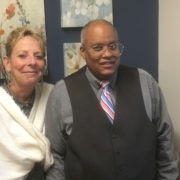Going the Distance: Jo Ann Simons Leads A Way Forward in the Human Services Field
It is the season for the salient female ‘edge’ in business. Women are on the precipice of breakthroughs and pioneering modernized practices across all fields. This is where Jo Ann Simons must find herself standing in the human services field. Jo Ann Simons is the CEO and vanguard extraordinaire of the distinguished Northeast Arc, a non-profit organization creating possibilities for the disability community to participate in everyday life and provide support for their families. Simons’ prerogative is actively pursuing innovative methods to elevate the human services field by facilitating better practices for inclusion and ways to utilize the skillsets of the disability community. Her prowess to redefine the status quo was fueled by her own experience of having a child born with a disability. Her degree in social work coupled with her own story has shaped her empathy, consciousness, and lifelong commitment to redefining disability programs and their accessibility in the northeast. For families, Northeast Arc collaboratively connects the community to opportunities to realize their potential and thrive in their environments. With Simons at the forefront of paving the road to enriched experiences and success for the disability community, the future is brightening.
Simons shares a few staggering statistics imploring all communities to change their perspective to lead sustainable efforts for better inclusion: One in six children in the United States today has a developmental disability, and 80% of individuals with disabilities are not included in the workforce and half of this population suffers from chronic loneliness. Woefully, more than a quarter of working-age Americans with disabilities live in poverty, compared to 10% of Americans who do not have a disability. These statistics call upon the community to awaken to the need for inclusion towards a more well-rounded society by integrating the talents of an underutilized community. Generally, the industry suffers from antiquated approaches, and management typically struggles with implementational change. Simons reinforces the incumbency of the community to guide its headway by presenting opportunities for higher independence for people living with disabilities.
The scope of Simons’ ambition is high as she sets her sights for the northeast to be the exemplar of how to integrate the disability community into the sphere of everyday life. Her passionate commitment to positive disruption aims to inspire other communities to be disruptive, as she declares action at this level is our human responsibility. Enter the Center for Linking Lives. The work of the Center for Linking Lives is singular in its vision but is more complex in the impact it endeavors to have on a national level. The Center for Linking Lives was established at the Liberty Tree Mall in Danvers, Massachusetts. The significance of this location is its visibility and access to the public realm to co-exist and engage with the disability community, bolstered by public transportation. The emblematic advantage of this location helps to exhibit how instituting an influential and engaging community center not only contributes to society but provides profound peace of mind for families. Simons remarks on the genesis of the Center for Linking Lives as the next bold step in helping individuals with disabilities to become full participants in their communities: “the access to stores, restaurants, services, and potential jobs in the mall will increase opportunities for real independence and inclusion. The ID/DD population needs to have access to regular activities and gain exposure to how people of all walks of life go about their daily lives–this crucial access leads to happier and healthier days.”
The Center for Linking Lives features key competency-enhancing and experience-driven training to achieve these goals. The adaptive equipment and a learning library strengthen boundless possibilities for comprehensive programming. There is a technology lab where individuals are trained on the latest digital platforms. There is also a test kitchen allowing experiential learning of essential food preparation. Small meeting rooms were constructed to provide one-on-one speech and where cognitive therapies and mock interviews happen to prepare neurodiverse talent who seek work. Socialization, in general, is a principal focus of the center and is supported by designated spaces for recreational programming.
Another advantageous influence on the community is parcels, a storefront in the mall selling products made by entrepreneurs with ID/DD worldwide. From California to Israel, parcels celebrates these 80 entrepreneurs contributing to society and business. parcels also operates as a constructive training ground for Northeast Arc’s workforce development program. parcels “shopping for a cause” is the epitome of a practical inclusion archetype and exhibits a replicable model for ID/DD communities.
Shared Spirits & Access-Driven
Simons heralds the funding of leading technologies for integration in the disability community space as essential to its advancement. The heart of the Arc Tank is to creatively inspire businesses innovating for the disability community through a fun, competitive fundraising event. The event is orchestrated in the same way a venture capital fundraising competition might be (think Shark Tank). Innovators pitch, and judges determine how much is given to fund their innovative designs. This creative fundraising model dynamically raises capital and awareness for leaders in the space. For example, Water Wise, a program that teaches children with autism how to swim, was awarded $30,000 to kick-start its journey. Fundraising in this vein reinforces the notion that ventures in this arena are no different from other imaginative VC investments. Simons views this capital raising model as a correlative for other communities who seek to cultivate innovation. Every participant is integral in these efforts and helps shift methodologies, as sharing information and innovation across all communities reshapes the paradigm.
Confidence-Building Technology
The idea that the human services space is a 0% risk environment means it is not particularly ripe for innovation because of the expected reliance on direct human interaction and attention. However, Simons presents technology as the clear solution to reduce the need for constant surveillance as it enables a mutually shared confidence-build for families and organizations. The essence of technology is its inherent adaptability and shareability. Thus, looking to other industries to use their technology is a viable strategy for inclusion. “Pre-existing technology can be adapted to cater to the disabled community easily, and we can borrow technology. The technology exists but needs to be imported so we can be a leader in that space,” Simons emphasizes. She also suggests that other community committees should include in strategic planning hiring high-level technical mavens to vet all available tools to determine the best investment. Technology evinced how easily agencies could adopt digital tools to pivot for dependable, remote service delivery during the pandemic. Simons shares her concerns that states will believe returning to pre-pandemic life will be enough and not recognize the advantages and silver lining of what technology propelled because of the pandemic.
Simons is impelled by empathy, logic, and data to support her case for technology’s critical role in creating an atmosphere of aspirational solutions. She espouses that empathy training has a greater chance of increased awareness through technology in how it changes the way services are delivered. Safety remains the paramount focus, but technology integration eases levels of dependency and begets improved independent living. Existing AI (Artificial Intelligence) and virtual reality technologies present solutions to aid in the training of self sufficiencies. Empathy training can be readily available using existing platforms that can be repurposed for particular usages. AI can recreate a person’s experiences in daily life so others can better understand and adapt to specific environmental conditions accordingly. There is real-time support available via camera systems with CareCoach to assist daily activities– think of Alexa but with real, human engagement and one-on-one care. Furthermore, AI helps identify patterns to introduce solutions to behaviors. Additional examples of effective digital accessories include bracelets that receive notifications, smart shoes with sensors that detect potential obstacles, and general video monitoring. MedMinder, a supplemental device that sends text and email alerts for taking medication, is another effective digital support measure reinforcing the notion of technology as a provider of comfort and alleviation by aiding in self-sufficiency. Equally important, technology also proves its ROI by lifting the barriers people have about how independent living can flourish with such support.
Technology lends itself to other significant facets — attracting, recruiting, and retaining staff. For the digitally native who are accustomed to an omnichannel life, technology can help to attract younger people into the workforce sooner. Integrated technology serves as a recruiting tool because of how it is evolving; it makes positions more compelling for staff to use innovation to perform more efficiently in their jobs.
Through Simons’ lens, technology is seen as the next human right. She believes it can empower all with fair chances and better experiences overall.
Acknowledgment
Responsive, resilient, strong, and innovative — these are the characteristics Simons possesses to lead the way forward. Her devotion to moving the needle on how the community perceives people living with disabilities is at the heart of what she does for Northeast Arc and as a community member herself. Leaders like Simons inspire change by the adoption of new conventions. She thinks beyond the bounds of her horizon and works diligently and passionately to create a vision for the future that is shareable for other communities. Her core mentality that there is always a solution creates opportunities to form safe spaces and peace of mind.
Waypoint Interactive would like to extend our profound appreciation to Jo Ann for her remarkable commitment, influential generosity of spirit, and dedicated time to cement a better future for our community.










Leave a Reply
Want to join the discussion?Feel free to contribute!